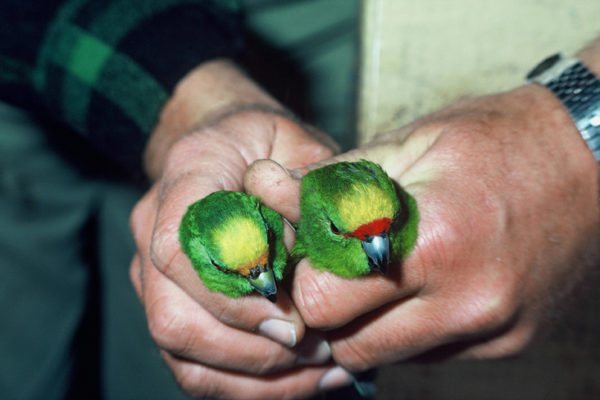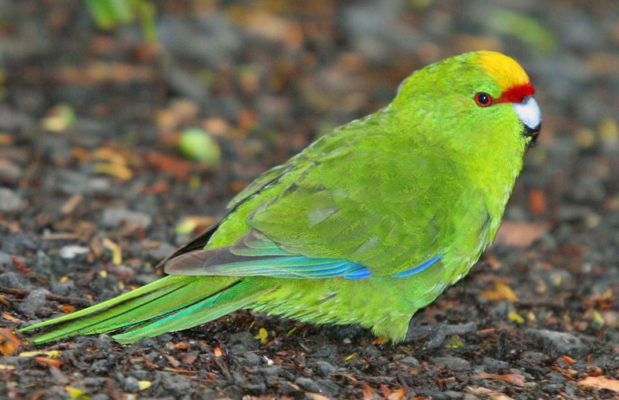Kakariki, our native parakeets mostly nest in holes in trees, where the female incubates the eggs for around 3-4 weeks. That makes female kakariki, as well as the young, particularly vulnerable to predators and could potentially lead to a male bias in the adult population.
Red-crowned kakariki are now only common on predator-free islands and yellow-crowned parakeets are also rare on the mainland – but rarest of all is the orange-crowned parakeet. It’s now only found in very small numbers in three alpine beech-forested valleys in the Canterbury region.

Once thought to be a colour-variation of the yellow, which is often found in the same habitat, the orange-fronted is now recognised as a separate species and estimates put the total population at 200-400 birds. When a population becomes that small, predation of females at the nest becomes particularly significant. If the adult population is male-biased – with more males than females, then the effective breeding population of the species is actually less than the 200-400 ‘head count’ would suggest. The species may be even more vulnerable than we realise.
So is there a male-bias in the sex ratio of orange-fronted parakeets? That’s what Jonathan Kearvell and Megan Farley from the Department of Conservation’s Rangiora office set out to find out in research published in Notornis, the Journal of the Ornithological Society of New Zealand.
“The total number of orange-fronted parakeets in this population is difficult to assess accurately, largely because they are spread over a considerable area of high alpine (Nothofagus spp.) forest (13,237 ha) and the populations are not banded. However, a recent survey estimates the population at around 150-200 mature birds and this is distributed throughout the Hawdon and Poulter Valleys in Arthur’s Pass National Park and the South Branch Hurunui River Valley in Lake Sumner Forest Park.”
Data on the sex ratio of adult birds was collected over a 6-year period from 2007-2012.
“Observers spent each day traversing the forested valleys identifying all orange-fronted parakeets to sex, where possible. Field data was collected, mostly in the austral summer between 2007 and 2012 and during each season between October and April. Birds were sexed using a combination of morphological traits as well as phenotypic differences and behavioural interactions. Known sexed birds in captivity were used to verify traits.”

“Males (40-52 g) are on average larger than females (30-41 g), with minimal overlap. Males tend to be more brightly coloured and with a bolder frons, while the plumage colours in females often appear slightly faded. The bill of males is also significantly longer than the bill of females. When observed in pairs, differences in size and coloration were usually visible, and in combination with behaviours such as courting, mating and breeding, sex could be assigned reliably. Solitary birds can be more difficult to sex, but with experience, sex could be assigned to most individuals based on plumage, size and behaviour. No individual was allotted sex unless the observer was certain.”
The results showed some sex-ratio bias towards males.
“Our surveys of the remaining populations of orange-fronted parakeet (Cyanoramphus malherbi) indicate this species currently has a non-breeding season adult male population proportion of between 0.56 and 0.66. This male bias increased to between 0.68 and 0.74 during the breeding season. Limited data also suggest that prior to recent declines in the population size of orange-fronted parakeets, driven largely by introduced mammalian predators, the adult sex ratio (ASR) may have been closer to parity. The excess of males indicates that this species currently has a compromised population structure, despite intensive conservation management undertaken since 2000 to limit predation.”
It’s not good news – but further research is necessary to find out to what extent the breeding population is compromised.
“There are many variables to consider when obtaining unbiased estimates of sex ratio in populations of wild birds, and our results have indicated the importance of accounting for time of season. Our method of estimating the ASR produced different ratios over a season, with fewer females observed during the breeding season. This bias is not unexpected if we examine the breeding behaviour of orange-fronted parakeet, as the female incubates the clutch exclusively over ~26 to 30 days. Therefore females during the breeding season can be inside the nest hole for considerable lengths of time, only coming off a few times each day to be fed by the male.”
Outside the breeding season, a male bias was still observed, however, albeit to a smaller degree.
“This supports our observations made in the pre-breeding period (when females are not on nests) of a smaller, though mostly significant male bias in the wild orange-fronted parakeet ASR of around 0.56 to 0.66. We suspect this male bias may result from high levels of predation from introduced mammalian predators that falls disportionately on nesting females, although data is needed on the mortality of females at the nest to test this hypothesis.”
The male bias has occurred in spite of predator control carried out to help protect the rare parakeets.
“The extant meta-population of wild orange-fronted parakeets does seem to have a male bias, even though the population is protected by large scale integrated pest control which should have been reducing the level of predation on females occupying nest holes. This suggests predator control has not been sufficient to prevent a male bias in the population.”
Surplus males can also potentially interfere with the success of breeding pairs.
“As a result of the currently skewed population, a potentially unusual behaviour has been noted by field staff. Extra-pair males of both species have been noted to persistently ‘hang around’ active nests, including inter-species aggressive courtship behaviour. Here the more common yellow-crowned parakeet (possibly also with a male-skewed population), have been observed aggressively courting female orange-fronted parakeet which appeared to have an attendant male orange-fronted parakeet. It should be noted that male yellow-crowned parakeet are larger (mean 51 g), than male orange-fronted parakeet (40-52 g). While these behaviours have not been monitored in detail, it is a potential example of increased aggressive competition by ‘spare’ males, which can result in nest intrusion by unpaired males resulting in egg loss or infanticide, or even established pair disruption. If this behaviour is indeed occurring within the small male-skewed orange-fronted parakeet meta-population, then it is another factor that will have a negative long term effect upon that population and thus the future conservation of the species. This warrants further investigation.”
There are a number of conservation implications for the longterm survival of orange-fronted kakariki.
“Certainly the critically endangered orange-fronted parakeet seems to have a male-skewed wild population. Even if a male skew is normal in this species, it has probably been exacerbated by increased predation on secondary cavity-nesting females. It is also possible that other causal factors may include reduced fitness, inbreeding and environmental and ecological factors.
“The reduction in the number of females has an obvious conservation issue within the meta-population. There are simply fewer mature females to produce the next generation, which in turn will reduce the overall genetic diversity of the meta-population. This also means that the effective population size is less than the census population size any survey has produced and this should be taken into account when undertaking any future threat status designations.”
The full research article is published in Notornis and is freely available online.

